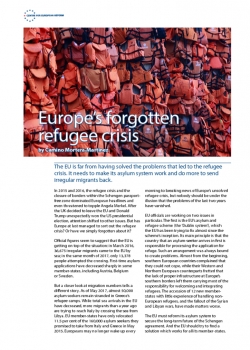
Europe's forgotten refugee crisis
The EU is far from having solved the problems that led to the refugee crisis. It needs to make its asylum system work and do more to send irregular migrants back.
In 2015 and 2016, the refugee crisis and the closure of borders within the Schengen passport-free zone dominated European headlines and even threatened to topple Angela Merkel. After the UK decided to leave the EU and Donald Trump unexpectedly won the US presidential election, attention shifted to other issues. But has Europe at last managed to sort out the refugee crisis? Or have we simply forgotten about it?
Official figures seem to suggest that the EU is getting on top of the situation: in March 2016, 36,675 irregular migrants came to the EU by sea; in the same month of 2017, only 13,378 people attempted the crossing. First-time asylum applications have decreased sharply in some member-states, including Austria, Belgium or Sweden.
But a closer look at migration numbers tells a different story. As of May 2017, almost 50,000 asylum seekers remain stranded in Greece’s refugee camps. While total sea arrivals in the EU have decreased, more migrants than a year ago are trying to reach Italy by crossing the sea from Libya. EU member-states have only relocated 11.5 per cent of the 160,000 asylum seekers they promised to take from Italy and Greece in May 2015. Europeans may no longer wake up every morning to breaking news of Europe’s unsolved refugee crisis, but nobody should be under the illusion that the problems of the last two years have vanished.
The EU has much more to do to avoid a collapse of the #Schengen area the next time a crisis hits.
Tweet thisBluesky thisEU officials are working on two issues in particular. The first is the EU’s asylum and refugee scheme (the ‘Dublin system’), which the EU has been trying to fix almost since the scheme’s inception. Its main principle is that the country that an asylum-seeker arrives in first is responsible for processing the application for refuge. Such an arrangement was always bound to create problems. Almost from the beginning, southern European countries complained that they could not cope, while their Western and Northern European counterparts fretted that the lack of proper infrastructure at Europe’s southern borders left them carrying most of the responsibility for welcoming and integrating refugees. The accession of 12 new member-states with little experience of handling non-European refugees, and the fallout of the Syrian and Libyan wars, have made matters worse.
The EU must reform its asylum system to secure the long-term future of the Schengen agreement. And the EU should try to find a solution which works for all its member-states. For example, it could try to maintain the principle of asylum in country of first entry insofar as numbers remain reasonable for countries to manage. If they do not, then a system of quotas – distributing refugees amongst member-states according to a pre-established formula – could be activated. To convince those countries who are more reluctant to take refugees in, these quotas could be complemented by a ‘buy-out’ scheme: all member-states would have to take in a minimum number of refugees; countries that did not wish to accept more than this minimum could then contribute, in kind or in cash, to the implementation of the EU’s asylum and migration policies (by, for example, sending case officers to refugee processing centres in Greece).
The second issue keeping officials busy is the return of rejected asylum seekers and irregular migrants, which is the most difficult part of any migration policy. Sending irregular migrants back to their countries of origin is, however, essential for making asylum policies work: if there is a clear distinction between those who are allowed to stay and who are not, it is easier for governments to take in those in need of protection.
Europeans may no longer wake up to news of the EU's #refugeecrisis but the problem has not vanished.
Tweet thisBluesky thisBut returns are complicated by several factors. First, it is often difficult to verify an irregular migrant’s country of origin. A wide diplomatic network, which smaller member-states often lack, is crucial for this, as it can help in liaising with national authorities. Second, countries are often reluctant to remove irregular migrants from their territory, as this may have to be done by force, and migrants might sue governments in the courts. Third, to send someone back, EU governments need the agreement of the migrant’s country of origin or transit, which is often not easy to obtain. The EU has been hesitant to negotiate return agreements alongside trade or development deals, in part because such conditionality may hamper economic growth and co-operation, and in part because some member-states have historic and commercial ties with sending or transit countries – such as France’s with many West African countries. But if Europe wants to have an effective asylum policy in place, it will need to be less shy in convincing third countries to take back their own nationals, in exchange for development aid or trade deals.
EU institutions are by design much better at slow-moving and highly technical issues than at solving acute crises. In the past two years they have shown a capacity to organise themselves at short notice to deal with the refugee crisis. But the EU has still much more to do if it wants to avoid a collapse of the Schengen area the next time a crisis hits.
Camino Mortera-Martinez is a research fellow and Brussels representative of the Centre for European Reform.

